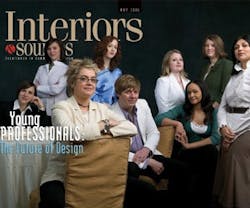Five years ago, Interiors & Sources hosted a roundtable discussion with 10 emerging young professionals in response to a trend we recognized would impact A&D firms in a meaningful way.
Specifically, with the first members of the Baby Boom generation turning 60, a demographic shift was looming within the workforce. A generational gap in the population following 1964 meant that there would be fewer young professionals to fill the vacancies left by senior members of design firms as they transitioned into retirement.
Given that the competition would be stiff among A&D firms searching to attract, recruit and retain young designers, we brought this group together to determine what the next generation of designers thought about the state of the industry, and what issues and trends were important to them. Topics ranged from how prepared they felt entering the workforce to mentorship, and from the critical importance of sustainability to the triviality of reality TV shows about "design."
Since then, we've endured the worst recession since the Great Depression—one that claimed the jobs of many in the A&D community—but are finally back on our way to some semblance of normalcy, where we can once again try to envision what the future might have in store. We thought it would be fitting, then, to catch up with a few of our roundtable participants to find out what they have been up to, how things have changed for them in the past five years, and to discuss where they think they (and the profession at large) may be in the next five.
Read the
May 2006
Young Professional
Roundtable article.
"These last five years have been filled with amazing opportunity," says Viveca Bissonnette, FIIDA, Associate AIA, CID, LEED AP and co-founder of Hollander Design Group. "I just recently went through a momentous change and left the firm I had been with for almost 10 years to start my own firm with my partner Jeff Hollander. I have been incredibly lucky. The partners of the firm I left were very supportive of my move and the new firm, Hollander Design Group, has been hugely successful during our first year, despite the economy."
Additionally, Bissonnette has been actively involved with IIDA and is currently president of the organization. She credits IIDA as having played a key role in the successes she has attained, which recently culminated with her induction to IIDA's College of Fellows.
In terms of what's ahead, Bissonnette says, "Our industry is undergoing radical changes driven by the economy, technology and a multigenerational workforce whose styles of working and needs are diverse. Flexibility is the word of the day. As an industry, we need to be open to change to stay current and relevant."
Cyanna Goold, NCIDQ, an interior designer at LMN Architects, echoes Bissonnette's point on technology. With programs such as Rhino, Cricket and Grasshopper making designing "so easy," she says "it will be interesting to see how 3-D modeling will continue to shape our designs. Young designers are using technology to produce their renderings, and the companies that provide 3-D models of their furniture are the ones I'm going to use." She admits that she hasn't opened a product binder from their resource library in some time unless she's looking for a physical sample—all of her research on products is done online or by flipping through magazines.
Having spent some time working for Starbucks corporate in Germany doing prototype store design before moving to LMN Architects, where her work "involves a lot of researching materials, furniture installation and aiding the architects," she is looking forward to advancing in the field and taking on creative opportunities. In the next five years, Goold is hoping to get to the point where she's in a senior management role and is developing design concepts for clients.
"The biggest change in my career since the young professionals article is that I have reached the level of principal," says Kevin Kenney, IIDA, LEED AP, principal at SKB Architecture and Design. Kenney now has a dual role that he didn't expect to have five years ago: he acts as both a design director, leading a team in creating solutions for clients, and as a marketer for the firm's efforts. "I still see myself as a designer first and foremost, but I hope to continue to polish my skills and expand my role on the business development side, as it has become an unexpectedly enjoyable part of my career."
Kenney adds that the key to SKB's survival through the recession was diversity. "SKB has always pushed back against the conventional wisdom that the key to success is specialization, and our staff's skills represent that. It allowed us to shift gears and market ourselves for unusual opportunities."
Indeed, diversity, technology and flexibility seem to be the drivers of change that will enable designers like these to continue to experience success in the industry. Where they will be, and where we will be as an industry, is yet to be seen. But if the past is any indication, the future is looking bright, and we can expect even more great things from this crop of professionals.
About the Author
Robert Nieminen
Chief Content Director
Chief Content Director, Architectural Products, BUILDINGS, and interiors+sources
Robert Nieminen is the Chief Content Director of three leading B2B publications serving the commercial architecture and design industries: Architectural Products, BUILDINGS, and interiors+sources. With a career rooted in editorial excellence and a passion for storytelling, Robert oversees a diverse content portfolio that spans award-winning feature articles, strategic podcast programming, and digital media initiatives aimed at empowering design professionals, facility managers, and commercial building stakeholders.
He is the host of the I Hear Design podcast and curates the Smart Buildings Technology Report, bringing thought leadership to the forefront of innovation in built environments. Robert leads editorial and creative direction for multiple industry award programs—including the Elev8 Design Awards and Product Innovation Awards—and is a recognized voice in sustainability, smart technology integration, and forward-thinking design.
Known for his sharp editorial vision and data-informed strategies, Robert focuses on audience growth, engagement, and content monetization, leveraging AI tools and SEO-driven insights to future-proof B2B publishing.

